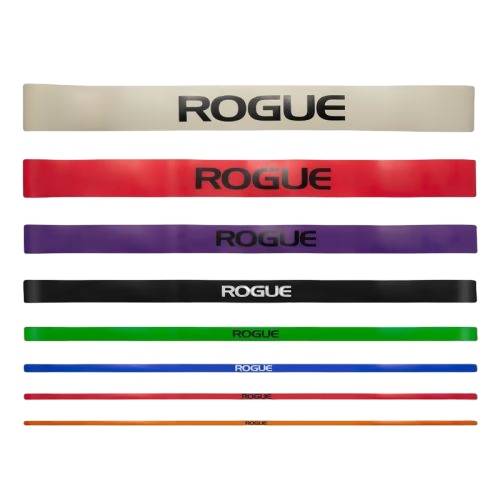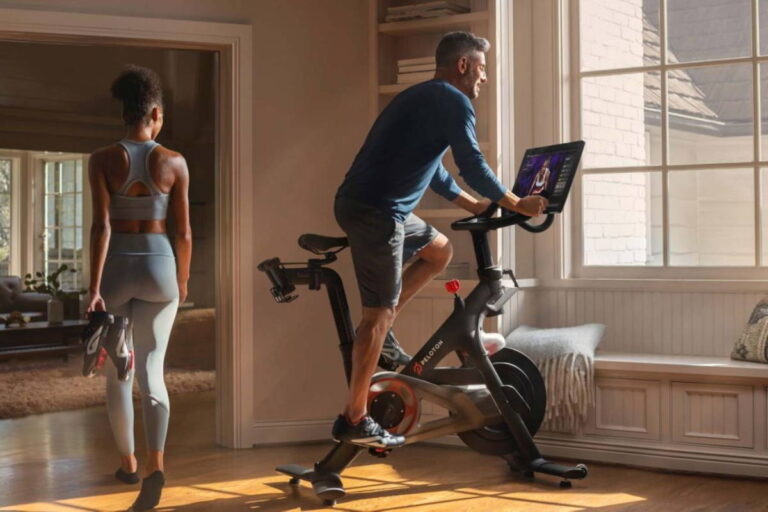Resistance Bands vs Weights: Which One Is Better for You?
So you want to know what is best, barbell or dumbbell shoulder press, we have the expertise and knowledge to help. Read on to find out which exercise needs to be included in your training program.
The resistance bands vs weights debate becomes valid if you have specific fitness goals. Resistance bands are more flexible and low impact to allow you exercise without so much extra stress, while free weights provide more load and allow you to track your progress a bit more.

Resistance Bands vs Free Weights: a Deep Dive
Weights vs resistance bands is an interesting debate. On the face of it, weights and resistance bands couldn’t be more different. Resistance bands are small and light, while free weights are huge and heavy. In fact, many people only use resistance bands to warm up before getting deep into their weightlifting movements. Yet weights and resistance bands are so similar in function that we’re having this conversation.
Each of them have different effects on your body so which one you go for will largely depend on what your fitness goals are. Let’s have weight training vs resistance training head to head in some critical categories to see exactly which one is for you. We’ll focus on strength building, cost, portability, muscles targeted, and precision.
1. Strength Building
Strength building is a huge goal for every fitness buff, and both resistance bands and weights offer plenty of it. Resistance bands are effective for building strength, especially for beginners, but you will eventually get to a plateau. The highest resistance bands are usually the equivalent of lifting about 200 pounds of weight so if you fall way below that, bands are good enough for you. Bands are also amazing for maintaining your strength and fitness levels.
That said, weights will provide more resistance over time. You get to lift heavier weights, which in turn builds up your muscle strength even more. You can go as heavy as you can imagine with free weights too. So if you’ve been using resistance bands and you’ve gotten to a plateau you’d like to break through, it’s better to graduate to free weights.
2. Cost
Free weights provide more resistance over time and are excellent value for money, but resistance bands cost way less. Free weights; whether barbells, dumbbells, or barbells; are valued at about $2 per pound, depending on brand and quality. That adds up to quite some money, but if your pockets are deep enough, and you have space to store your weights, it’s a good investment to make.
Resistance bands, on the other hand, are much more affordable. You can get a set of bands with 15 to 65 pounds of resistance for about the same price as a pair of10 pound dumbbells. Because weights are much heavier, they also cost more to ship. So if you’re on a budget and not looking to lift huge weights, resistance bands are amazing value.
3. Portability
Success in any endeavor is heavily dependent on consistency, and fitness is no different. If you’re a traveling person or just quite busy, you might want to get you some resistance bands. A resistance band with about 30 pounds of resistance will weigh less than 6 ounces and will easily fit into your bag or even your pocket.
Weights are heavy, bulky, and not so easy to carry around. You also need to ensure your floor is padded in case you drop the weights. Resistance bands relieve you of all that.

4. Muscles Targeted
Muscles targeted are another difference between resistance bands and weights. Resistance bands target the smaller muscles in your body that are often overlooked by weights. This makes them perfect for rehabilitation or beginner movements. Weights target the big muscles such as glutes, quads, and back muscles. This makes them more adept for advanced exercises.
5. Precision
Precision is one of the major advantages weight training has over resistance training. Bands are more variable when it comes to tracking your progress. You never really know for sure how much work your muscles are doing. The resistance in the band greatly depends on how far you’re stretching it, so you would have to stretch it to the limit to get the full weight equivalent.
With weights, it’s much more precise and easy to track. You know exactly how much weight you’re lifting and you can steadily improve by slowly increasing the weights you lift with a systematic approach known as progressive overload. This helps you effectively grow better and lift heavier, which in turn translates to improved performances. You can do progressive overload with resistance bands as well, but it’s far from precise and much harder to track

Range of Movements
Another advantage free weights have over resistance bands is there are multiple types. So you can break this debate down to resistance bands vs dumbbells, kettlebells, and barbells. This means that while resistance bands give a wider range of movements when paired with each type of free weight, 3 types of weights with various movements peculiar to each combine to overwhelm bands.
Barbells are the most rigid, but also take the heaviest weights. They don’t engage your stabilizing muscles since there’s equilibrium on both sides. This allows you to focus on lifting as heavy as you can. Dumbbells engage your stabilizing muscles more, and can be used to train one side at a time which is especially useful if you have a weaker side. Finally, kettlebells are used for swinging movements that make them perfect for training power and agility. So even within free weights, you have a decision to make on which one suits you best.
Resistance bands, on the other hand, allow as much flexibility as you would need. They’re more suited to pulling or stretching movements as opposed to the lifting movements of free weights. They allow you to do body weight exercises like squats and presses, and also allows more flexible movements like shoulder rotations and side-to-side exercises. So if you’re looking for flexible movements and low impact training, bands are the way to go.
Resistance Bands vs Free Weights: a Summary
So are resistance bands as effective as weights? Depending on what your fitness goals are, they might even be better than weights. If you’re looking for low impact and flexible training, don’t bother going for weights. They’ll give you exactly what you want without costing you or forcing you to stay in one place.
If you’re trying to lift more weight and build more strength, you can start with resistance bands but you’ll have to move onto weights eventually. Barbells let you lift as much weight as possible, dumbbells are awesome for targeted lifting, and kettlebells will make you more agile and explosive.
Pros and Cons
Let’s wrap this bands vs weights summary up with some pros and cons.
Pros of Resistance Bands
✅ Low impact, good for rehabilitation and beginners
✅ Cheap
✅ Portable, easy to control
✅ More flexible
Cons of Resistance Bands
❌ Limited strength building
❌ Lack of precision
❌ Less durable
❌ Less range of movements
Pros of Free Weights
✅ Best for strength building
✅ Precise, easy to measure
✅ Durable
✅ Wider range of movement
Cons of Free Weights
❌ Too heavy and bulky for carrying around
❌ More difficult to master and control
❌ More difficult to master and controlExpensive
❌ Reduced range of movement for individual types of weight
Resistance Bands vs Free Weights: When to Use Each
1. Band Thruster
Can resistance bands replace weights? One of the best examples of this is the banded thruster. A barbell thruster is a combination of the front squat and the overhead press. It starts with you holding a barbell and dropping to a squat position, then thrusting yourself upwards till you’re standing upright with your arms stretched as far as they can. A banded thruster isn’t much different.
Step on the inside a looped band to give yourself an anchor and stand up straight. Drop to a squat position similar to a barbell thruster. Then, just like the barbell thruster, explode upwards till you’re standing upright with your arms stretched straight up as far as they can. Instead of a barbell, you’ll be pushing the resistance band. Remember that the more you stretch, the more the resistance. You can watch it happen if you’re a bit confused.

2. Spanish Squat
The Spanish squat is extremely effective for targeting your quads. It involves using your resistance bands as an anchor for your legs such that your starting position has you leaning backwards. From this starting position, squat till you’re in a “sitting” position. Keep your back vertical, your thigh horizontal, and your hamstring vertical as much as you can. Then go back to your starting position and repeat. This movement puts your quads to work and develops the muscle.
3. One-armed Banded Row
This is important as it means one shoulder cannot dominate the other and work harder which is an issue that can arise with barbell exercises.
Best Workouts for Free Weights
There are three types of free weights, so we will look at each of them individually. Make sure to look each one up or even get a trainer to show you exactly how to do it, because form and technique are the key to a safe and effective workout.
Barbell
1. Deadlifts
Brutal and designed for gaining maximum muscle mass, deadlifts involve the heaviest weights. Stand with your toes underneath the barbell and with shoulder-length distance between them. Bend your knees to a squat and slowly lift up the barbell until it’s around your thigh and you’re standing upright. Finally, slowly lower it back to the ground. Make sure to keep your back straight and maintain control of your barbell.
2. Bench Press
Barbell exercises usually involve the heaviest weights, and bench press is no exception. It starts with you lying down with your face up and your glutes and shoulders flat on the bench. The barbell will be racked up above you. Reach up and grab it, then lift up and down.
Dumbbell
1. Cross Body Hammer Curl
This workout is amazing for your arms and chest especially. Stand upright holding a dumbbell in each arm. Then lift one arm across your body as if reaching for the shoulder on the opposite side. So lift your right arm across your body till the barbell touches your left breast, then do the same with your right.
2. Goblet Squat
The goblet squat is quite straightforward to do. Spread your legs to about shoulder length and stand upright holding a single dumbbell between your legs. Still holding the dumbbell, squat slowly and rise back up. Make sure to keep your arms straight throughout the routine.

Kettlebell
1. Kettlebell Swing
The kettlebell swing starts with you standing upright, holding a kettlebell with both hands between your legs. You must then squat slightly and explode upwards back into an upright position, but swinging the kettlebell upwards with your arms. Keep your back and your arms straight as you move.
2. Kettlebell Goblet Squat
If you’re thinking you’ve seen this before, yes you have. The kettlebell goblet squat is quite similar to the dumbbell goblet squat with one major difference. The dumbbell goblet squat requires you to hold a dumbbell with both hands between your legs and keep your arms straight as you squat. The kettlebell goblet squat, on the other hand, requires you to hold the kettlebell to your chin as you squat.
How to Use Resistance Bands with Free Weights?
So we’ve seen the difference between resistance bands and weights. We’ve also learned different workouts you can use each one to perform. Resistance bands and weights are not always on opposite sides of a debate, however. Sometimes they can be used together!
If you want to increase your max load, but don’t have any extra weights around, pairing your weights up with a resistance band is an amazing improvisation. For example, you can loop a resistance band around your dumbbell when doing a goblet squat so that as you rise, there’s extra resistance. Another example is the barbell curl. Instead of just lifting the barbell by itself, anchor a resistance band and combine it. This extra load provides more resistance for you.
How to Pick Resistance Bands?
If you’re interested in getting yourself some resistance bands, it’s easy to get ripped off into buying low quality ones. Here are some things you should look out for to make sure you’re getting good value for money.
1. Color
With resistance bands, colors are just there for variety. Each color signifies a different level of resistance. Yellow means extra light, and red says light. Green is medium, blue says heavy, and black stands for extra heavy. So pick depending on what you need it for. Yellow and red are good enough for warm up and rehabilitation work, and the heavier ones are better for strength building.
2. Quantity
It’s always better to buy a set of resistance bands as opposed to buying a single one. It allows you to have all the levels of resistance so you can grow and progress.
3. Type
There are two types of resistance bands: flat and tube. Flat bands have less resistance and are best for rehabilitation work. Tube bands are more durable and offer more resistance. They’re best for experienced lifters looking for some extra load.
Our Recommended Resistance Bands
As far as resistance bands go, you won’t find many better than the Rogue Echo resistance bands. 41 inches of durable latex rubber, they’re built to serve your exact needs. They come in 8 color codes ranging between mild, average, and intense. They can be used for any number of workouts from powerlifting to fitness. If you’re in the market for resistance bands, these are perfect.
FAQ
Can I replace weights with resistance bands?
Yes, but only to a certain level. As you progress, you will eventually get to a point where you need to graduate to weights for more intense training.
Do resistance bands build muscle faster than weights?
According to Strength Level, a novice gym goer should be able to lift 99 lbs, and someone who has been training for around a year should be able to lift 142 lbs.
Can you workout with resistance bands everyday?
One important, but often neglected part of fitness is recovery time. In eagerness to reach your goals, make sure to give your body the time it needs to recover. It’s okay to do resistance training as much as 6 times a week depending on your level of experience and fitness.
Conclusion
Are resistance bands better than weights? They’re easier to control and carry around, and they cost much less. That said, at some point you’ll want to move up to weights to continue your development. You can also use both weights and resistance bands together for even better results.
Now it’s your turn. What are your fitness goals? Do you prefer weight or resistance training? Is there anything else you’d like to share? Leave a comment!
Also Read:
- Squats With Resistance Bands
- Resistance Band Tricep Workout
- Resistance Band Chest Exercises
- Resistance Band Lat Pull Down
- Best Long Resistance Bands
- Bicep Exercises With Resistance Bands
- Best Door Anchor For Resistance Bands
- Row With Resistance Bands
References:
- Progressive overload explained: How to follow this simple training principle // Fitandwell:
https://www.fitandwell.com/features/progressive-overload-explained-how-to-follow-this-simple-training-principle - How To Do The Barbell Curl For Biceps Size And Strength // Barbend : https://barbend.com/barbell-curl/
Why Trust Us?
With over 20 years in Olympic Weightlifting, our team does its best to provide the audience with ultimate support and meet the needs and requirements of advanced athletes and professional lifters, as well as people who strive to open new opportunities and develop their physical capabilities with us.
By trusting the recommendations of our certified experts in coaching, nutrition, dietology, and sports training programming, as well as scientific consultants, and physiotherapists, we provide you with thorough, well-considered, and scientifically proven content. All the information given in the articles concerning workout programming, separate exercises, and athletic performance, in general, is based on verified data. We ensure that you can rely on our professionals’ pieces of advice and recommendations that can be treated as personalized ones which will benefit you and fully meet your needs.
The product testing process is described in more detail here
Author: Tanya Shaiko
News Editor, Olympic Lifting Enthusiast
Best Results: Snatch – 61 kg,
C&J – 78 kg
I’m Tanya, and I just can’t do without fitness. About six years ago, I got into Olympic weightlifting and instantly fell in love with it. Weightlifting is like no other sport – it’s just you versus the bar. Driven by my unwavering passion for an active lifestyle, I’ve been eager to share my personal journey and sports enthusiasm with others. As a journalist and photographer, my interests come full circle, adding an extra dimension to the news column that I curate. This way, I keep my readers updated with the latest happenings in the sports world.








